Trout Creek Ranch Noxious Weed Surveys
ODLT needs 2-4 volunteers to assist Brooke Gray, our Trout Creek Ranch Restoration Manager, with surveying or removing noxious weeds at Trout Creek Ranch Headquarters, as well as taking solo trips into the Pueblo and Trout Creek Mountains. Noxious weeds are plants considered to be harmful to the environment or animals. Identifying and removing them can help with our restoration plans, particularly along Trout Creek. Removal can include hand-pulling and weed eating. The most common weeds found at Trout Creek Ranch include perennial pepperweed, Scotch thistle, Russian knapweed, Russian olive and whitetop.
Skills and equipment needed/most helpful: Ability to identify plants (especially noxious weeds) at various stages of the plant life cycle. Willingness and ability to hike long distances on uneven terrain and for extended periods of time. Ability to hike in various weather conditions. We recommend carrying insect repellent and a mosquito net, since there will be bugs in the headquarter meadows. Data will be collected using an app called QuickCapture, which will require a smartphone. We also recommend having a phone app for navigation (Avenza, Gaia GPS, OnX, etc.) as well as a camera for taking pictures of unknown plants. Much could be accomplished hiking in the lowlands of Trout Creek Ranch Headquarters, while navigating to the more remote parcels of the ranch will require the use of a UTV, ATV, or high clearance vehicle.
WHEN:
A variety of days between May and July, or October and November depending on your schedule and activity at the ranch. This time will be most important since weeds will be in the rosette or flowering stage, making them easier to identify. Brandon Palmer, our Regional Stewardship Lead, will lead an orientation session on using the QuickCapture app.
WHERE:
Trout Creek Ranch headquarters (about 15 min south of Fields), and within the Pueblo and Trout Creek Mountains.
Google Maps Directions. (Additional directions will be provided).

Next Steps
Please register and, if you haven’t already, fill out our Volunteer Application & Liability Form to participate. Afterward, we’ll contact you with details.
Wildlife Camera Videos
Related Reads
Going with the flow
We're restoring a creek to help fish and wildlife.
A land of learning
Local Tribal members shared stewardship practices to inspire youth.
Looking out for the birds
Volunteers help guide restoration plans with wetland bird surveys.
Virtual fences mooove cows online
Virtual fence is a new technology that can help land managers maintain wildlife connectivity in permitted grazing areas.
Tribal Gatherings
Tribal leaders discussed the Native history and stewardship of their homelands at Trout Creek Ranch.
Research fueled by fire
Oregon State University finished 10 years of fieldwork on sage-grouse responses to wildfire.
Tribal Stewards
Tribal teens lead on conservation efforts through Northwest Youth Corps.
Spring returns
Rod Klus returns to researching sage-grouse for Oregon Department of Fish and Wildlife.
Mountains of Research
Researchers spent a summer in the mountains and left with more than data.
Spreading wings in conservation
Jack Strang created new connections to the high desert during our first internship.
Neighbors helping neighbors fight fires
Rangeland Fire Protection Associations protect the high desert and each other.
Spring into recreation & conservation
John Sterling works at the intersection of both as a volunteer board member.
















